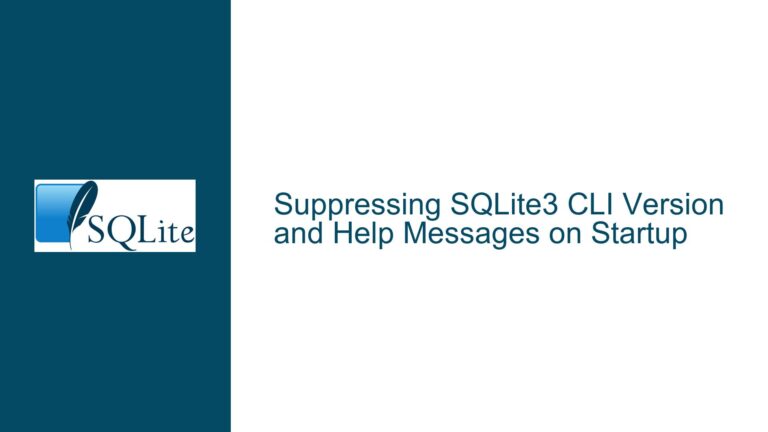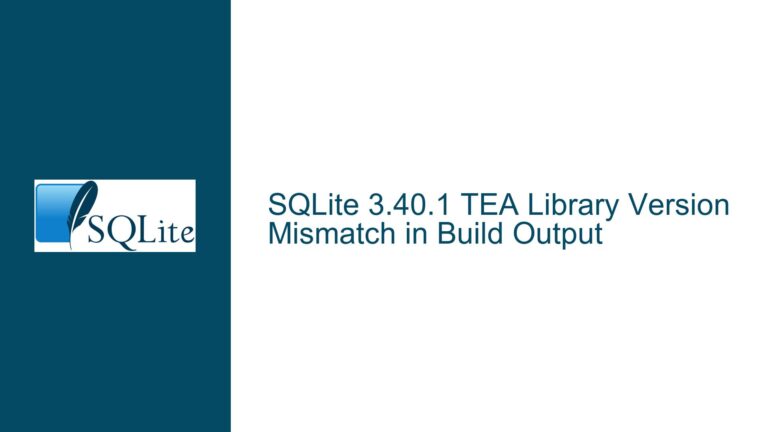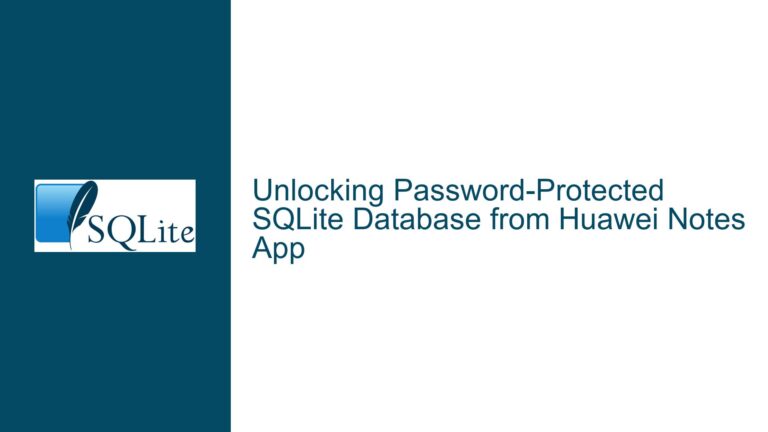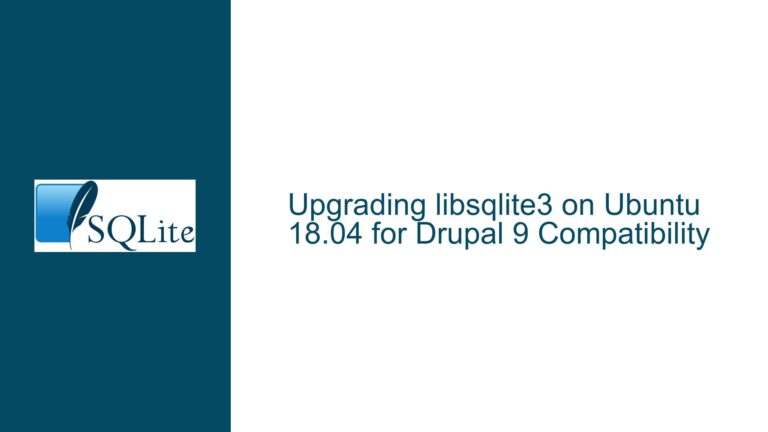SQLite Hooks and Cross-Connection Modifications
Issue Overview: SQLite Hooks and Cross-Connection Modifications
SQLite provides a variety of hook APIs that allow developers to monitor and react to changes within a database. These hooks include commit hooks, rollback hooks, update hooks, pre-update hooks, and WAL (Write-Ahead Logging) commit hooks. The primary question at hand is whether these hooks are invoked only when changes are made through the connection that registered the hook, or if they are also triggered when changes originate from a different connection, either within the same process or from another process entirely.
The documentation for SQLite’s C API is somewhat ambiguous on this point. While it is clear that hooks are registered with a specific connection, the language used in the documentation leaves room for interpretation. For instance, the WAL commit hook documentation states that it is "invoked each time data is committed to a database in WAL mode," which could imply that the hook is database-wide rather than connection-specific. In contrast, the documentation for other hooks, such as the update hook, uses language that suggests the hook is tied to the connection that registered it.
The core issue arises when multiple instances of a server application are running, each potentially making modifications to the same SQLite database. The developer needs an accurate timestamp to track when the database was last modified, regardless of which connection or process made the change. The challenge is to determine whether SQLite’s built-in hooks can provide this functionality or if a custom solution is required.
Possible Causes: Why SQLite Hooks May Not Be Cross-Connection
The primary reason SQLite hooks may not be cross-connection lies in the architecture of SQLite itself. SQLite is designed to be a lightweight, embedded database engine, and as such, it does not include a built-in server process to manage connections or coordinate activities between them. Each connection to an SQLite database is independent, and hooks are registered on a per-connection basis. This means that a hook registered with one connection will not be aware of changes made through another connection.
The WAL commit hook is a potential exception to this rule. Because WAL mode involves a shared memory (SHM) file that is used by all connections to the database, it is possible that the WAL commit hook could be triggered by changes made through any connection. However, even in this case, the documentation does not explicitly state that the hook is cross-connection, and the behavior may depend on the specific implementation details of the WAL mode.
Another factor to consider is the distinction between a "connection" and a "database" in SQLite. A single database file can be accessed by multiple connections, but each connection operates independently. This means that even if two connections are accessing the same database file, they do not share state or hooks. The hooks registered with one connection will not be aware of changes made through another connection, unless those changes are explicitly communicated between the connections.
Troubleshooting Steps, Solutions & Fixes: Implementing Cross-Connection Modification Tracking
Given that SQLite hooks are not inherently cross-connection, developers who need to track modifications made through any connection to a database must implement a custom solution. Below are several approaches to achieve this, each with its own trade-offs in terms of complexity, performance, and accuracy.
1. Polling the data_version Pragma
One approach is to periodically poll the data_version pragma, which returns a value that increments each time the database is modified. This value is global to the database, meaning it will change regardless of which connection made the modification. By polling this value at regular intervals, you can detect when changes have been made to the database.
However, this approach has several limitations. First, it does not provide an accurate timestamp of when the modification occurred; it only indicates that a change has been made. Second, polling introduces latency, as changes will not be detected until the next poll interval. Finally, frequent polling can impact performance, especially if the database is large or under heavy load.
2. Monitoring File Modification Times
Another approach is to monitor the modification times (mtime) of the database file and associated journal or WAL files. When a transaction is committed, the modification time of the database file or WAL file will change. By monitoring these times, you can detect when modifications have been made.
This approach has the advantage of being relatively simple to implement and does not require any changes to the database schema or application logic. However, it also has several drawbacks. First, the modification time may not always accurately reflect when a transaction was committed, especially in WAL mode where changes may not be written to the main database file immediately. Second, this approach may not be reliable on all filesystems or operating systems, as some may not update modification times with sufficient granularity.
3. Implementing a Custom Notification System
A more robust solution is to implement a custom notification system that tracks modifications made through any connection to the database. This can be done by creating a separate table in the database that records the timestamp of each modification. Each time a modification is made, the application would update this table with the current timestamp.
This approach has the advantage of providing an accurate timestamp for each modification and does not rely on polling or filesystem behavior. However, it requires modifying the application logic to update the timestamp table with each modification, which can be error-prone and may impact performance if not implemented carefully.
4. Using the sqlite3_update_hook in Combination with a Shared State
If you are willing to limit your solution to a single process, you can use the sqlite3_update_hook in combination with a shared state to track modifications across multiple connections. The idea is to register the update hook with each connection and have the hook update a shared state (e.g., a global variable or a shared memory segment) with the current timestamp whenever a modification is made.
This approach provides accurate timestamps and does not require polling or filesystem monitoring. However, it is limited to a single process and does not work across multiple processes. Additionally, it requires careful management of the shared state to avoid race conditions or other concurrency issues.
5. Leveraging the WAL Commit Hook
If you are using WAL mode, you can leverage the WAL commit hook to track modifications. The WAL commit hook is invoked each time data is committed to the database in WAL mode, and it may be possible to use this hook to detect modifications made through any connection. However, as previously discussed, the documentation does not explicitly state that the WAL commit hook is cross-connection, and the behavior may depend on the specific implementation details.
If you choose to use this approach, you will need to carefully test the behavior of the WAL commit hook in your specific environment to ensure that it meets your requirements. Additionally, you will need to handle the case where the database is not in WAL mode, as the WAL commit hook will not be available in other journal modes.
6. Combining Multiple Approaches
In some cases, it may be necessary to combine multiple approaches to achieve the desired functionality. For example, you could use the data_version pragma to detect when changes have been made and then use a custom notification system to record the exact timestamp of the modification. Alternatively, you could use file modification times as a fallback mechanism in cases where the custom notification system is not available or not reliable.
Combining multiple approaches can provide a more robust solution, but it also increases the complexity of the implementation. Careful consideration should be given to the trade-offs between accuracy, performance, and complexity when choosing which approaches to combine.
Conclusion
Tracking modifications made to an SQLite database across multiple connections is a challenging problem that requires careful consideration of the available options. While SQLite’s built-in hooks provide a powerful mechanism for monitoring changes, they are not inherently cross-connection and may not meet the needs of all applications. By understanding the limitations of these hooks and exploring alternative approaches, developers can implement a solution that provides accurate and reliable tracking of database modifications, regardless of which connection or process made the change.






